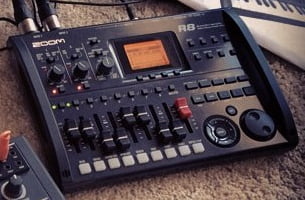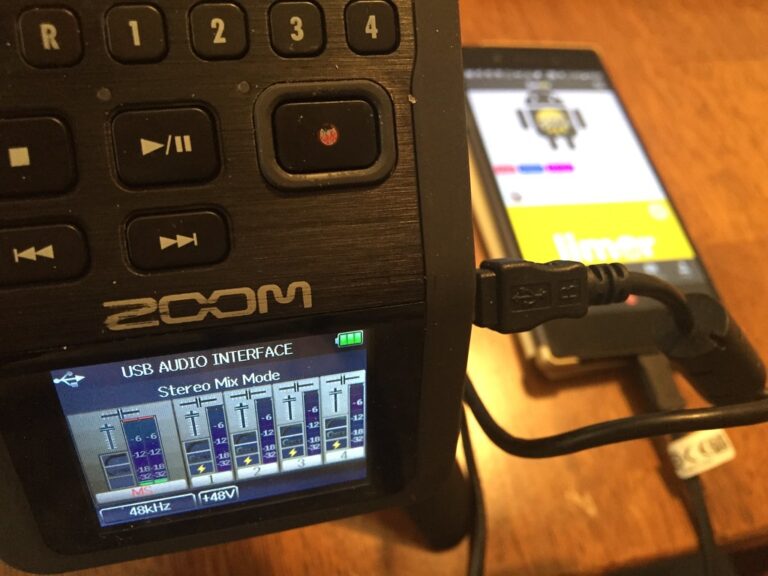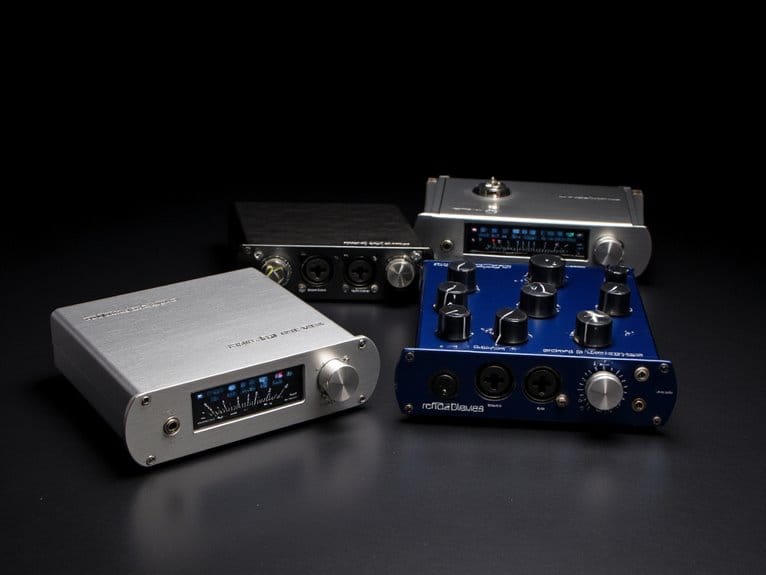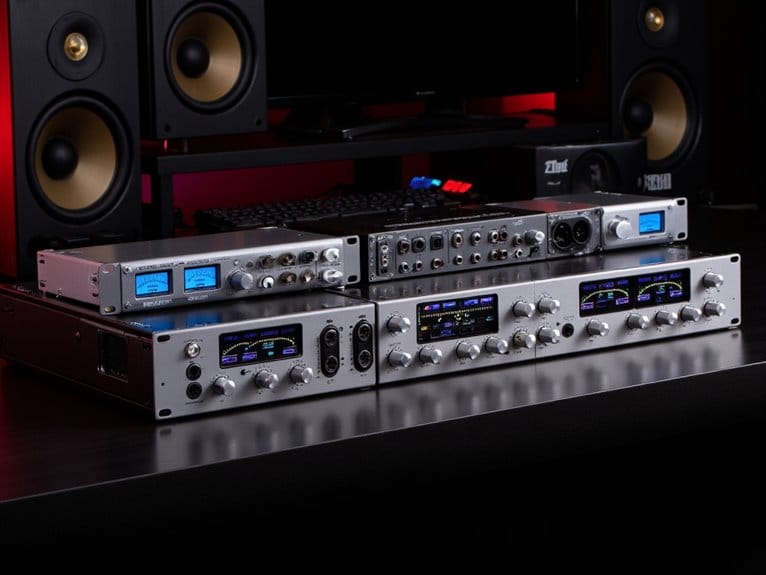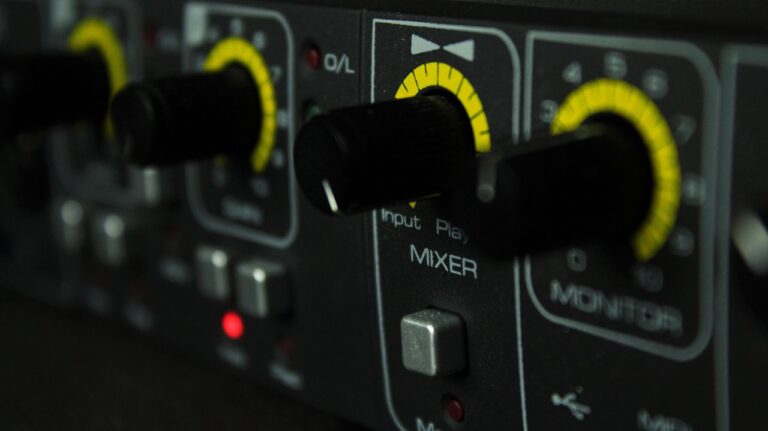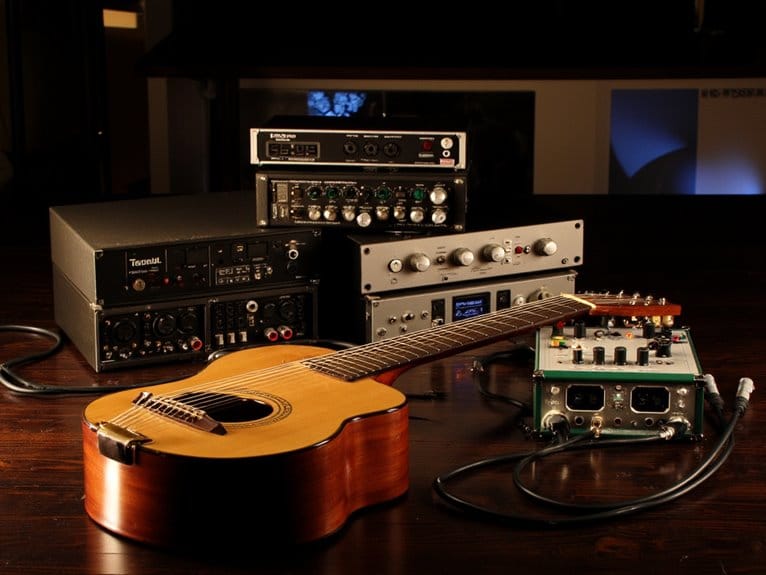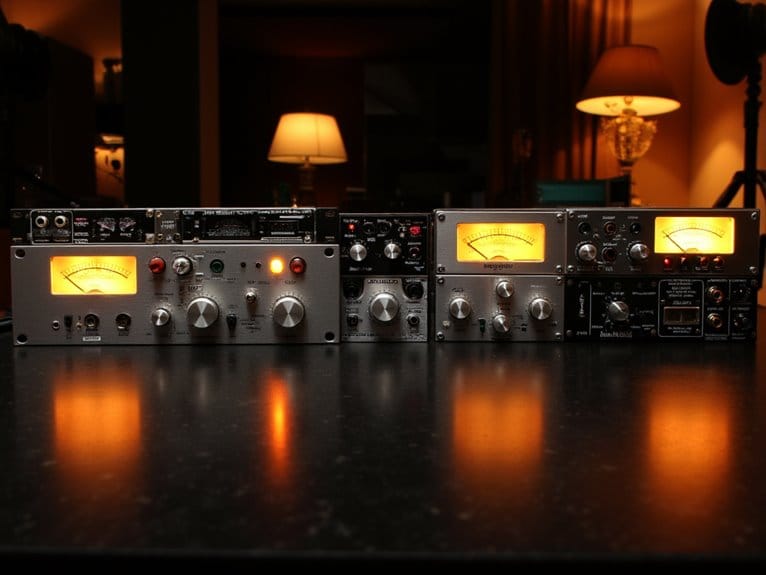Understanding Audio Interface Connectivity: USB Vs. Thunderbolt Vs. PCIe
When comparing audio interface connectivity options like USB, Thunderbolt, and PCIe, it’s important to assess speed, compatibility, stability, cost, latency, performance optimization, computer specifications, and the importance of preamps and converters for high-quality audio production. Thunderbolt boasts high-speed bandwidths like 20 Gbps for Thunderbolt 2 and 40 Gbps for Thunderbolt 3, while USB options vary from 480 Mbps in USB 2.0 to up to 10 Gbps in USB-C. Thunderbolt is known for low latency, while USB may have higher latency. PCIe offers high-speed data transfer and stability. When discussing cost, Thunderbolt interfaces tend to be pricier due to licensing fees, whereas USB is more budget-friendly. Factors such as adjusting buffer sizes, optimizing computer specs, and utilizing quality preamps and converters play critical roles in enhancing audio production. Preamps amplify mic signals, converters transform analog signals, and selecting interfaces with high-quality preamps and converters significantly influences sound quality. Understanding these connectivity options in depth can immensely benefit your audio setup’s performance and overall quality.
We are supported by our audience. When you purchase through links on our site, we may earn an affiliate commission, at no extra cost for you. Learn more.
Speed and Bandwidth Comparison
In comparing speed and bandwidth among various audio interface connectivity options, Thunderbolt 2 stands out with an impressive 20 Gbps rate, a speed that is doubled by Thunderbolt 3 at 40 Gbps. Thunderbolt interfaces offer blazing-fast data transfer speeds, making them ideal for high-resolution audio recording and playback. On the other hand, USB audio interfaces have evolved over the years, with USB 2.0 providing a bandwidth of 480 Mbps, USB 3.0 reaching 4.8 Gbps, and the latest USB-C supporting up to 10 Gbps. These varying speeds cater to different audio devices, from basic setups to more demanding professional systems.
Firewire interfaces are renowned for their stable and consistent speeds, making them a reliable choice for audio and data transfer tasks where essential performance is vital. PCIe interfaces, commonly found in desktop computers, excel in high-speed data transfer, offering a preferred solution for users requiring rapid connectivity for their audio interfaces. Each interface type has its strengths and is suited to different audio production environments based on the speed and stability requirements.
Compatibility and Stability Factors
When evaluating audio interface connectivity, it is essential to contemplate the reliability of the connections, the influence of system requirements on compatibility, and the evaluation of software compatibility. These factors play a significant role in ensuring stable performance and seamless integration within audio production setups. By analyzing connectivity reliability, system requirements, and software compatibility, users can make informed decisions when selecting the most suitable interface for their specific needs.
Connectivity Reliability Considerations
Considering the compatibility and stability factors of connectivity in audio interfaces, it is essential to evaluate the reliability of different interface options such as Thunderbolt, USB, Firewire, PCIe, and Ethernet.
- Thunderbolt: Widely compatible with Mac and Windows systems, ensuring broad usage.
- USB: Offers standardization and compatibility across Mac and PC, making it a widely available and stable choice.
- Firewire: Provides low latency and stable performance for audio connections, commonly found in older devices.
- PCIe: Used in desktop computers, offering low latency and stability due to direct high-speed data transfer capabilities.
Each interface option has its strengths concerning stability, compatibility, and low latency, allowing users to choose based on their specific needs and setup requirements.
System Requirements Impact
Exploring the impact of system requirements on connectivity stability and compatibility reveals important insights for selecting the most suitable audio interface option. Thunderbolt technology, prevalent in current computers and common in Mac systems, guarantees compatibility with a wide range of devices. USB interfaces, found across Mac and PC platforms, offer extensive compatibility with various systems. PCIe interfaces, commonly in desktop computers, provide low latency and stability due to high-speed data transfer capabilities, making them ideal for audio applications. Firewire interfaces, although more common in older devices, deliver stable performance and low latency for audio applications. Understanding how these interfaces align with system requirements is essential to achieving stable performance and compatibility in audio setups.
Software Compatibility Assessment
Software compatibility evaluation for audio interfaces involves examining various factors related to compatibility and stability to ensure peak performance in audio setups. When evaluating software compatibility, considerations such as the type of interface being used and the operating system in question play a vital role.
- USB interfaces are known for their widespread compatibility across Mac and PC platforms.
- Thunderbolt technology offers compatibility with both Mac and Windows systems, ensuring broader usability.
- PCIe interfaces are commonly utilized in desktop computers, providing high-speed data transfer and low latency for audio processing.
- Ethernet interfaces are recognized for their stability and low latency in data transfer, making them suitable for networking setups in studios.
Cost Analysis of Interface Types
When considering the cost analysis of different interface types for audio connectivity, it becomes essential to examine the nuances of pricing factors. Thunderbolt interfaces often come with a higher price tag due to licensing fees and specialized components. In contrast, USB interfaces are generally more budget-friendly, benefiting from widespread adoption and economies of scale in production. Comparing the cost differences among various interface types offers insight into the value each option provides for different audio setup budgets. Additionally, understanding how interface costs relate to overall audio setup efficiency can influence purchasing decisions. For instance, while investing in a Thunderbolt interface might result in higher initial expenses, it may offer lower latency and superior audio quality for professional applications. Furthermore, the distinction of ‘instrument cable vs speaker cable explained‘ can further clarify how different components within an audio setup can also impact performance and cost.
Cost Differences Explained
In comparing the cost differences among various audio interface types, it is important to take into account factors such as licensing fees, manufacturing costs, and technological advancements. When evaluating the cost-effectiveness of different interfaces, USB stands out for its budget-friendly nature due to standardization and widespread availability. Thunderbolt interfaces often come at a higher price point than USB and PCIe options, primarily due to licensing fees and increased manufacturing costs. Firewire interfaces, although potentially lower in cost compared to Thunderbolt, are less common in modern devices. PCIe interfaces offer a range of pricing options based on features and specifications, catering to users with varying budgets. Additionally, Ethernet interfaces are generally considered cost-effective for networking setups, offering reliable data transfer at a reasonable price.
Budget-Friendly Options Comparison
Comparing the budget-friendly options among audio interface types involves analyzing the cost-effectiveness of USB, Thunderbolt, PCIe, Firewire, and Ethernet interfaces. USB interfaces are known for their cost-effectiveness due to standardization and market availability. Thunderbolt interfaces tend to be pricier because of licensing fees and higher manufacturing costs. Firewire interfaces present a budget-friendly option compared to Thunderbolt, attributed to the older technology. PCIe interfaces offer a range of cost options depending on features. Ethernet interfaces are also considered cost-effective, especially for networking setups, providing an affordable alternative to Thunderbolt, USB, Firewire, and PCIe interfaces. Understanding the various manufacturing costs, licensing fees, and technological advancements associated with each interface type is essential in determining the most budget-friendly option for audio interface connectivity.
Value for Money
For a thorough assessment of the cost-effectiveness of different audio interface types, a detailed analysis of the initial investment and long-term value provided by each interface is essential. When considering the value for money in audio interfaces, several factors come into play:
- USB interfaces: Cost-effective due to standardization and widespread availability.
- Thunderbolt interfaces: Tend to be pricier because of licensing fees and higher manufacturing costs.
- Firewire interfaces: May offer lower costs as they are based on older technology and are less common in newer devices.
- PCIe interfaces: Varied costs based on features and specifications, offering flexibility in pricing.
Understanding the cost implications of USB, Thunderbolt, Firewire, and PCIe interfaces is paramount in making an informed decision regarding your audio setup.
Latency Considerations in Audio Interface
When evaluating latency considerations in audio interfaces, the direct high-speed connection of PCIe to the computer chipset stands out as an important factor in reducing audio transfer delays compared to USB and Thunderbolt. PCIe interfaces offer a more direct pathway for data transmission, minimizing the time it takes for audio signals to travel between the interface and the computer’s processing unit. In contrast, USB and Thunderbolt interfaces often involve additional buffering and slower serial connections, which can lead to increased latency in audio transfer.
Real-time audio applications, such as live recording or monitoring, require low latency to guarantee seamless audio processing. While Thunderbolt interfaces generally offer lower latency compared to USB, FireWire interfaces also excel in providing real-time support due to their efficient data transfer capabilities. Driver optimization and hardware integration are vital aspects of reducing latency in audio interfaces, as they directly impact the efficiency of data processing and signal routing within the system.
Performance Optimization Techniques
To enhance the performance of your audio interface setup, implementing targeted strategies for optimizing system resources and minimizing latency is essential. When focusing on performance optimization techniques, there are several key factors to contemplate:
- Adjusting Buffer Sizes: By modifying buffer sizes in your recording software, you can minimize roundtrip latency and optimize CPU performance, especially when working with virtual instruments.
- Utilizing Bus Effects Processing: Incorporating bus effects processing can help reduce latency and enhance the efficiency of your audio interface workflow, providing a smoother experience during recording and playback.
- Optimizing Computer Specifications: Take into account your computer specifications when setting up your audio interface. Factors like CPU speed, RAM, and storage can have a profound impact on performance and latency.
- Managing Power Settings: Pay attention to power management settings on your computer. Adjusting these settings can sometimes enhance performance by ensuring that your system resources are allocated efficiently for audio processing tasks.
Impact of Computer Specifications
Computer specifications play an important role in determining the latency and overall performance capabilities of audio interfaces. When comparing USB interfaces to PCIe, factors such as CPU performance and RAM capacity have a substantial impact on the efficiency of real-time audio processing. A computer with higher CPU clock speeds and multiple cores can handle audio tasks more effectively, leading to reduced latency. Additionally, having sufficient RAM is vital as it allows for smoother operation and better multitasking, ultimately optimizing the performance of the audio interface.
Moreover, power management settings on the computer can affect the stability and latency of audio interfaces during recording and playback sessions. It is essential to make sure that power settings are configured to prioritize performance over power saving to avoid interruptions or delays in audio processing.
Furthermore, adjusting buffer sizes in audio software is another critical aspect when considering the impact of computer specifications on audio interfaces. By optimizing buffer sizes based on the processing capabilities of the computer, users can fine-tune latency levels and enhance overall performance. Hence, understanding and optimizing computer specifications such as CPU performance, RAM capacity, power management settings, and buffer sizes are essential for maximizing the potential of audio interfaces, whether using USB or PCIe connections.
Importance of Preamps and Converters
Optimizing the performance of audio interfaces involves understanding the critical role of preamps and converters in capturing and reproducing audio signals accurately.
- Preamps in audio interfaces play a pivotal role in amplifying mic and instrument signals before conversion to digital. High-quality preamps are essential as they help capture audio signals with precision and minimal noise interference.
- Converters in audio interfaces are responsible for transforming analog signals to digital and vice versa. Quality converters are vital for ensuring the faithful representation of audio, maintaining the integrity of the original sound with minimal distortion.
- Selecting audio interfaces equipped with superior preamps and converters is paramount for achieving high-quality recordings. These components have a profound impact on the overall sound quality and fidelity of the recordings, making them indispensable for professionals and enthusiasts alike.
- When aiming for accurate recordings, investing in audio interfaces with excellent preamps and converters is a strategic decision that can elevate the quality of your audio production, ensuring a clean, transparent, and true-to-source sound reproduction.

